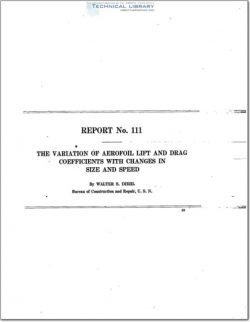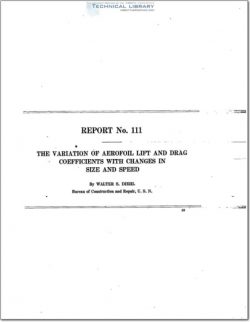naca-report-111

- Version
- 126 Downloads
- 600.81 KB File Size
- 1 File Count
- August 18, 2016 Create Date
- August 18, 2016 Last Updated
National Advisory Committee for Aeronautics, Report - The Variation of Aerofoil Lift and Drag Coefficients with Changes in Size and Speed

This investigation is concerned with the determination of the functions of at which express
the variation of lift and drag coefficients of an aerofoil, with particular reference to the appli-
cation of model tests to full-size airplane performance.
It should be noted that the condition of dynamic similarity, which may be expressed
c,l,= 1231,, presupposes geometrical similarity. This is equivalent to saying that geometrically
similar aerofoils will give identical characteristic curves when tested at speeds inversely pro-
portional to their chords.
This interchangeability of u and l and the dependence of aerofeil coefficients upon their
product has beenaccepted for many years as being necessary from a physical standpoint. The
validity of the assumption has sometimes been challenged but never disproved. On the other
hand the results of various tests such as those made at N. P. L. on: two geometrically similar
aerofoils (Br. A. C. A. R. and M. No. 148) and at Gottingen on several series of geometrically_
similar aerofoils. (Kumbruch—Zeitschrift fi'ut Flugtechnik und Motorluftschifl'ahrt, May 31
1919) are to be taken as positive proof.
However it is well known to everyone who has his occasion to study the results of many
aerofoil tests that there are certain limits within which it is necessary to keep both a and 2 if
the data are to be reliable. For instance if the velocity of the wind during a test be less than
30 f. p. s., or if the chord of the model be less than 3 inches, the flow is determined not only by
the aerofoil section but aiso by the method of supporting the model and the quality of the air
flow, or turbulencepresent in air stream. _The upper limit to velocity depends chiefly upon
compressibility and may arbitrarily be set at 200 f. p; s., at which speed the effect is of the order
of 1 per cent.
| File | Action |
|---|---|
| naca-report-111 The Variation of Aerofoil Lift and Drag Coefficients with Changes in Size and Speed.pdf | Download |

Comment On This Post